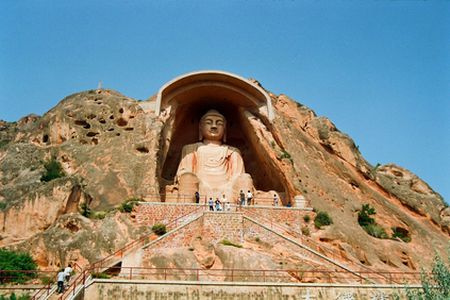须弥山石窟
Mount Xumi Grottoes are located on the eastern slope of the mountain about 60 kilometres northwest of Guyuan County.Ningxia Hui Autonomous Region.
须弥山石窟位于宁夏回族自治区固原县西北约60公里的山峰的东部斜坡上。
The ideal geographical position of the mountain has a close bearing on the building of the grottoes.
山的理想地理位置关系到石窟的建筑。
The area used to be a key passage on the ancient Silk Road between the East and the West and also a thoroughfare for exchanges between the Han and other ethnic groups of China.
该地区曾是东方和西方之间古丝绸之路一个关键通道,也是中国汉族和其他民族的一个交流大道。
Therefore,it was the scene of many battles.
因此,它是许多战斗的战场。
In the Sui (581-618) and Tang (618-907) dynasties, people built temples on the mountain in token of their appeal for peace and stability and against war and murder as well as their faith in Buddhism.
隋(581 - 618)和唐(618 - 907)时期,人们在山上建造庙宇,做为呼吁和平与稳定,反对战争和谋杀以及他们对佛教的信仰的标志。
The most celebrated place of interest in the mountain is the Giant Sitting-Buddha Maitreya in Grotto No 2.
最著名的名胜古迹是山上2号洞的弥勒大座佛。
The Maitreya measures 26 metres in height,with its ears the length of two adults put together.
弥勒佛有26米高,耳朵的长度两个成年人的总和。
The Maitreya has a benign look.It is considered a representative masterpiece of the grotto in the mountain.
弥勒菩萨有一个和蔼的面容。它被认为是代表山中洞穴的杰作。

Grotto No 5 is the biggest of its kind in the mountain.Made of a mound hollowed out,it is called the “ Haloes of Xumi”.
5号石窟山中同类最大。由掏空的土地做成,它被称为“须弥之光环”。
The grotto consists of seven Well-preserved Buddhist statues,each six metres tall,arid seven Bodhisattva statue.
石窟由七个保存完好的佛教雕像组成,每一个有六米高,七菩萨雕像。
These sculptures look mysterious and fascinating under a few rays of light that enter the grotto through a hold in the mound.
几缕阳光进入洞穴时这些雕塑看起来神秘而迷人。
Subjected to devastation by earthquakes and windstorms in its 1,400-year history,half of the grotto was caved-in,but it has recently been restored.
在其1400年历史中受到地震,暴风的破坏,一半洞穴都塌方了,但是最近被修复了。


